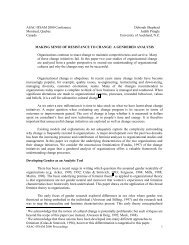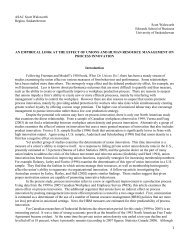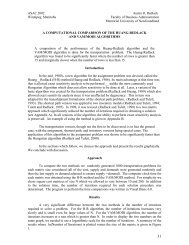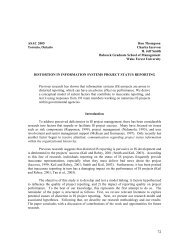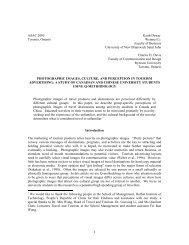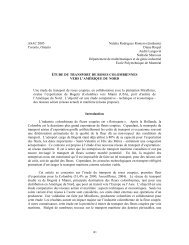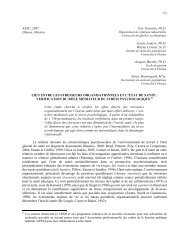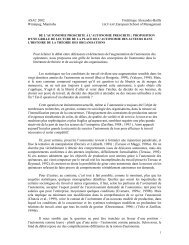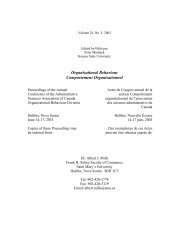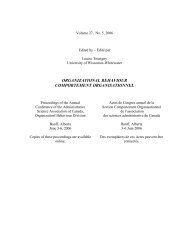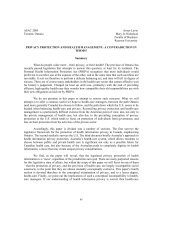Global Operations Strategy in Service Businesses
Global Operations Strategy in Service Businesses
Global Operations Strategy in Service Businesses
You also want an ePaper? Increase the reach of your titles
YUMPU automatically turns print PDFs into web optimized ePapers that Google loves.
country units. The <strong>in</strong>ternational firm <strong>in</strong> these service <strong>in</strong>dustries would be manag<strong>in</strong>g a portfolio ofbus<strong>in</strong>esses <strong>in</strong>stead of be<strong>in</strong>g true global corporation.The strategic options available to the firm change rather fundamentally when we consider the caseof the global <strong>in</strong>dustry. Porter (1986) observes; “In a global <strong>in</strong>dustry, manag<strong>in</strong>g <strong>in</strong>ternationalactivities like a portfolio will underm<strong>in</strong>e the possibility of achiev<strong>in</strong>g competitive advantage. In aglobal <strong>in</strong>dustry, a firm must, <strong>in</strong> some way <strong>in</strong>tegrate its activities on a worldwide basis to capturethe l<strong>in</strong>kages among countries. This <strong>in</strong>tegration will require more than transferr<strong>in</strong>g <strong>in</strong>tangibleassets, though it will <strong>in</strong>clude such transfer. A firm may choose to compete with a country-centeredstrategy, focus<strong>in</strong>g on specific market segments or countries where it can carve out a niche byrespond<strong>in</strong>g to whatever local country differences are present. However, it does so at someconsiderable peril from competitors with global strategies. All the important competitors <strong>in</strong> theglobal <strong>in</strong>dustries listed above compete worldwide with <strong>in</strong>creas<strong>in</strong>gly coord<strong>in</strong>ated strategies.”The viable strategic options open to a firm depends on the extent of the globalization of its<strong>in</strong>dustry. Firms compet<strong>in</strong>g <strong>in</strong> multidomestic <strong>in</strong>dustries are constra<strong>in</strong>ed to deploy multidomesticstrategies that manage a portfolio of bus<strong>in</strong>esses, while those compet<strong>in</strong>g <strong>in</strong> global <strong>in</strong>dustries,although they can choose to deploy multidomestic strategies, would be at a considerablecompetitive disadvantage if they do so. The <strong>in</strong>escapable conclusion is that <strong>in</strong> a global <strong>in</strong>dustry, thefirm must deploy some sort of global strategy.The Value Cha<strong>in</strong> and <strong>Global</strong> <strong>Operations</strong> <strong>Strategy</strong>A firm can be viewed as perform<strong>in</strong>g a set of value activities that create and deliver value to thecustomer and which generate marg<strong>in</strong>s, as <strong>in</strong> Figure 1. The def<strong>in</strong>ition of global operations strategiesconsiders both how the firm configures these activities across its national or geographic units,what is referred to as configuration, and how <strong>in</strong>tensely these units are coord<strong>in</strong>ated from a centrallocation, the firm’s home-base or global platform. Configuration options range from concentrat<strong>in</strong>gthe performance of all value activities <strong>in</strong> the firm’s home base to dispers<strong>in</strong>g across manygeographic locations. Where a company chooses to concentrate the performance of value cha<strong>in</strong>activities, it serves all geographic regions from its home base and performs <strong>in</strong> each national marketonly the downstream activities that are necessary to ma<strong>in</strong>ta<strong>in</strong> its market presence. These requisitem<strong>in</strong>imum downstream activities usually <strong>in</strong>volve the operation of sales office and the establishmentof an after-sales service operation. Where the company chooses to disperse the performance of thevalue cha<strong>in</strong> activities, it can, at the outrance, perform all the value cha<strong>in</strong> activities <strong>in</strong> each countrythat it competes <strong>in</strong>, fundamentally treat<strong>in</strong>g the global <strong>in</strong>dustry as a set of multidomestic markets.Figure 1The Value Cha<strong>in</strong>FIRM INFRASTRUCTUREHUMAN RESOURCE MANAGEMENTTECHNOLOGY DEVELOPMENTPROCUREMENTINBOUND OPERATIONS OUTBOUND MARKETING SERVICE MLOGISTICS LOGISTICS AND SALES (After-sales) ARGMARGINThe second dimension of global strategy is coord<strong>in</strong>ation or the extent to which the strategic andoperations decisions related to like or l<strong>in</strong>ked activities <strong>in</strong> one country are related to those of other74
promotes both concentration of activities and their coord<strong>in</strong>ation across service creation anddelivery units, whether these units are <strong>in</strong>volved <strong>in</strong> the performance of primary or support valuecha<strong>in</strong> activities.Figure 2Types of International <strong>Strategy</strong> and the<strong>Global</strong> <strong>Operations</strong> <strong>Strategy</strong> Frontier of <strong>Service</strong> Bus<strong>in</strong>essesHighCoord<strong>in</strong>ationof ActivitiesHigh ForeignSimpleInvestment with<strong>Global</strong>Extensive Coord<strong>in</strong>ation<strong>Strategy</strong>Among SubsidiariesLowIncreas<strong>in</strong>gCoord<strong>in</strong>ationConcentrationGeographicallyDispersedSource: Adapted from Porter, 1986.andGeographicallyConcentratedThe purest form of global strategy, the simple global strategy of Figure 2, <strong>in</strong>volves both highconcentration and tight coord<strong>in</strong>ation of activities. Concentration is done to achieve high economiesof scale or to exploit the comparative advantage or the cost or differentiation advantage of aparticular location, although concentration also promotes coord<strong>in</strong>ation. It is far easier to coord<strong>in</strong>ateactivities that are located <strong>in</strong> close proximity than those that are geographically dispersed. So, whena company competes <strong>in</strong>ternationally, it <strong>in</strong>creases the complexity of the coord<strong>in</strong>ation problems andissues it must deal with and can only be successful <strong>in</strong> the global market if it can f<strong>in</strong>d ways toassure tight coord<strong>in</strong>ation of performance of value cha<strong>in</strong> activities and the relevant organizationalunits. A firm is deploy<strong>in</strong>g a global strategy if it seeks to ga<strong>in</strong> a competitive advantage bycompet<strong>in</strong>g <strong>in</strong>ternationally either through the concentration or dispersion of value activities acrossits national units, or through coord<strong>in</strong>ation of these units or through both concentration/dispersionand coord<strong>in</strong>ation.<strong>Global</strong> <strong>Operations</strong> <strong>Strategy</strong> Options for <strong>Service</strong> Bus<strong>in</strong>essesFigure 2 gives us the conceptual base that we need to outl<strong>in</strong>e the <strong>in</strong>nate global strategy optionsavailable to service firms and to understand how astute service managers have been able toposition their companies to be effective global competitors <strong>in</strong> their markets. Because servicescannot be <strong>in</strong>ventoried and usually cannot be exported, the service delivery system usually must belocal <strong>in</strong> scope. The global strategies that require high geographic concentration of at least the coreservice delivery process or operations and those value cha<strong>in</strong> activities such as <strong>in</strong>bound andoutbound logistics that are strongly related to operations, are not available to most service firms,unless management deploys actions that have the consequence of <strong>in</strong>creas<strong>in</strong>g the level ofconcentration. We can deduce from Porter’s framework that firms reap the greatest competitiveadvantage from both high levels of concentration and tight coord<strong>in</strong>ation among domestic units.The coord<strong>in</strong>ation problem for many service firms is complex <strong>in</strong>deed, and this further restricts theability of service firms to deploy pure global strategies. The complexity of the coord<strong>in</strong>ation76
problem derives from three factors. First, most service corporations that compete <strong>in</strong>ternationallymust manage a very large number of operat<strong>in</strong>g units <strong>in</strong> a large number of domestic (national)markets. For example, McDonald’s has over 23,000 restaurants <strong>in</strong> at least 34 countries, whileFEDEX has thousands of service centers <strong>in</strong> over 200 countries. Second, when compared withmanufactur<strong>in</strong>g <strong>in</strong>dustries, the primary value activities of service bus<strong>in</strong>esses are often spl<strong>in</strong>tered.For example, market<strong>in</strong>g activities <strong>in</strong> service bus<strong>in</strong>esses have a classical, external market<strong>in</strong>gcomponent and a rather very critical <strong>in</strong>ternal market<strong>in</strong>g one, the former be<strong>in</strong>g the doma<strong>in</strong> of themarket<strong>in</strong>g function, while the latter is essentially lodged <strong>in</strong> the service delivery operation, underthe purview of operations. As a second example of spl<strong>in</strong>ter<strong>in</strong>g, take the example of airl<strong>in</strong>ecompanies where the <strong>Operations</strong> value activities can be divided <strong>in</strong>to reservations operations,typically under the direction of Market<strong>in</strong>g and Sales, and flight and ground operations under thedirection of the <strong>Operations</strong> function. Spl<strong>in</strong>ter<strong>in</strong>g imposes more severe coord<strong>in</strong>ation requirements,s<strong>in</strong>ce it <strong>in</strong>troduces more dist<strong>in</strong>ct activity sets <strong>in</strong> the value cha<strong>in</strong> that are often the responsibility ofdifferent organizational units.Thirdly, service tastes, demand and consumption patterns are more susceptible to local socialcultural<strong>in</strong>fluences and companies that want to compete <strong>in</strong>ternationally must make peripheraladaptations to the core service to cater to local social and cultural idiosyncrasies. Some cases ofadaptation of the service to local tastes by add<strong>in</strong>g peripheral elements to a central core are shown<strong>in</strong> Figure 3. It must be emphasized, however, that these adaptations to local social-cultural<strong>in</strong>fluences usually leave the core service <strong>in</strong>tact, s<strong>in</strong>ce the existence of a hard service corefacilitates <strong>in</strong>creased coord<strong>in</strong>ation, a key factor <strong>in</strong> the ability of a service firm to compete<strong>in</strong>ternationally.Figure 3The <strong>Service</strong> Core and Adaptations to Local Social-CulturalInfluences: The Case of McDonald’sTeriyakiMcBurger:Hamburger, FrenchFriesCurry PotatoPie:Hong KongPeripheral<strong>Service</strong>Core<strong>Service</strong>Peripheral<strong>Service</strong><strong>Service</strong>Soy Burgers;IndiaCoke, Sundae,‘Pout<strong>in</strong>e’;QuebecNote: Pout<strong>in</strong>e (pronounced pooteen) is a menu item of French fries overlaid with melted cheese.It is particular popular <strong>in</strong> fast food restaurants <strong>in</strong> French Canadian culture.F<strong>in</strong>ally, because services are fundamentally <strong>in</strong>tangible or impalpable, they often cannot bespecified with a high level of precision, and there are usually no physical measures of either thenature of the service or of performance of the service delivery system. The various elements of aservice concept are often fungible and performance evaluation has a very strong subjectivecomponent. Consequently, <strong>in</strong> the absence of mechanisms to impose a corporate wide servicediscipl<strong>in</strong>e, deviation of the actual service from the <strong>in</strong>tended service is easy and will most likelyoccur. In that case, local tastes, wants and consumption idiosyncrasies are constantly tugg<strong>in</strong>g atthe core of the service offer<strong>in</strong>g to adapt it to local wants, even if this would compromise the<strong>in</strong>tegrity of the core service. The service company that wants to compete <strong>in</strong>ternationally mustbuild the organizational capability to ma<strong>in</strong>ta<strong>in</strong> service design and delivery discipl<strong>in</strong>e <strong>in</strong> the face ofsuch parochial pressures from the local market. These service companies that are compet<strong>in</strong>g77
<strong>in</strong>ternationally must execute the service <strong>in</strong> a wide array of domestic markets, across a broadspectrum of cultures, and still ma<strong>in</strong>ta<strong>in</strong> the strategic and service operations execution discipl<strong>in</strong>ethat will ma<strong>in</strong>ta<strong>in</strong> the <strong>in</strong>tegrity of the service concepts and of the company’s competitive position.This is one of the biggest management challenges of firms compet<strong>in</strong>g <strong>in</strong>ternationally <strong>in</strong> a servicemarket, and the companies that succeed as global competitors have built the organizational,strategic capability to effectively deal with it.These arguments mean that service firms have <strong>in</strong>nately fewer global operations strategy options, anarrower range of attractive global operations strategies, and less potential to reap competitiveadvantage from globalization of operations than their manufactur<strong>in</strong>g counterparts. We canenvisage a frontier of <strong>in</strong>nate global operations strategies for service bus<strong>in</strong>esses as shown <strong>in</strong> Figure2, and it shows that the global strategy space <strong>in</strong>nately available to service bus<strong>in</strong>esses is muchmore restricted than that available to manufactur<strong>in</strong>g firms, the latter potentially occupy<strong>in</strong>g theentire global strategy space. For service bus<strong>in</strong>esses to become effective global competitors, theymust broaden the range of strategic options open to them by <strong>in</strong>creas<strong>in</strong>g their global operationsstrategy space. This can be achieved by design<strong>in</strong>g and implement<strong>in</strong>g actions that make it possibleto have higher levels of concentration of the location of value cha<strong>in</strong> activities, coupled withcoord<strong>in</strong>at<strong>in</strong>g mechanisms or service design and delivery strategies that make it economical toachieve tight coord<strong>in</strong>ation of both domestic units and the execution of value cha<strong>in</strong> activities.As shown <strong>in</strong> Figure 2, the actions that <strong>in</strong>crease concentration and coord<strong>in</strong>ation push the globalstrategy frontier of service bus<strong>in</strong>esses upward and to the right, thus <strong>in</strong>creas<strong>in</strong>g their globalstrategy space. Top managers <strong>in</strong> a few lead<strong>in</strong>g-edge service bus<strong>in</strong>esses have been able to designand deploy effective global operations strategies that make their companies true globalcompetitors. They do so by deploy<strong>in</strong>g service design and delivery strategies that either allowthem to <strong>in</strong>crease the level of concentration of value cha<strong>in</strong> activities or create the potential toachieve tight coord<strong>in</strong>ation of domestic organizations and service delivery units or both. Theselevels of concentration and coord<strong>in</strong>ation must be achievable over and above what would normallybe realizable given the nature of the service <strong>in</strong> question.The barriers to concentration are substantially physical. For example, there is absolutely no wayto deliver a freshly prepared hamburger from Los Angeles to Tokyo, us<strong>in</strong>g current technology.The concentration enhanc<strong>in</strong>g actions that <strong>in</strong>crease the capability of a service firm to compete<strong>in</strong>ternationally will focus on reduc<strong>in</strong>g the physical barriers to deliver<strong>in</strong>g the output of the relevantactivity set from where it is concentrated (produced) to where it is used. However, the barriers tocoord<strong>in</strong>ation are also economic, s<strong>in</strong>ce one can theoretically coord<strong>in</strong>ate any set of activitiesperformed <strong>in</strong> one location with any other set of activities performed <strong>in</strong> a different location, andthis could be done by a variety of mechanisms, as po<strong>in</strong>ted out previously. In the case ofcoord<strong>in</strong>ation enhanc<strong>in</strong>g actions, what is at stake is the tightness of the coord<strong>in</strong>ation achieved andits cost. So the actions that create the potential to achieve high levels of coord<strong>in</strong>ation will focuson dramatically reduc<strong>in</strong>g the cost of coord<strong>in</strong>at<strong>in</strong>g value activities and domestic units over a widegeographical area.Push<strong>in</strong>g the <strong>Global</strong> <strong>Service</strong> <strong>Operations</strong> <strong>Strategy</strong> Frontier :Differentiation and IntegrationWe use the value cha<strong>in</strong> <strong>in</strong> Figure 4 to outl<strong>in</strong>e the specific actions that many service firms haveimplemented that help them compete effectively <strong>in</strong>ternationally. The figure further bolsters theusefulness of the value cha<strong>in</strong> concept as a tool of operations strategy analysis and design. Thevalue cha<strong>in</strong> analysis shows that despite the <strong>in</strong>herent disadvantages of services compared tomanufactur<strong>in</strong>g when it comes to compet<strong>in</strong>g <strong>in</strong>ternationally, the level of concentration ofperformance of value activities and their coord<strong>in</strong>ation across nationalorganizations and domestic markets can be <strong>in</strong>creased significantly from a base level. This<strong>in</strong>crease <strong>in</strong> concentration and coord<strong>in</strong>ation has the effect of push<strong>in</strong>g the global service strategyfrontier closer toward the simple global strategy option available to manufactur<strong>in</strong>g corporations.This can be achieved with clear global operations strategy <strong>in</strong>tent by us<strong>in</strong>g the value cha<strong>in</strong>, astrategic management framework, to map out the actions that must be implemented <strong>in</strong> order toenhance concentration and coord<strong>in</strong>ation mechanisms that are specific to each value activity.78
Quite amaz<strong>in</strong>gly, the actions outl<strong>in</strong>ed <strong>in</strong> Figure 4 <strong>in</strong>volve the application of the fundamentalconcepts of management, Differentiation and Integration. We recall that differentiation is theprocess of recogniz<strong>in</strong>g that different organizational units or activities have different requirements,constra<strong>in</strong>ts, logic or processes and must usually be separated from other dissimilar activities ordepartments, so as to maximize both their own <strong>in</strong>ternal efficiencies and their potential impact onthe organization as a whole. Differentiation <strong>in</strong>volves the recognition and management ofdifferences or uniqueness. Therefore, our framework does not advocate the creation of differencesbut rather argues that the usual classification of value activities may result <strong>in</strong> dissimilar subactivitiesbe<strong>in</strong>g bundled together and managed as one, <strong>in</strong>divisible whole. Where this results <strong>in</strong> theentire activity set be<strong>in</strong>g dispersed throughout the domestic organizations, concentration potential islost. The concept promulgated here argues for divid<strong>in</strong>g the value activities <strong>in</strong>to unique subcategoriesand concentrat<strong>in</strong>g those amenable to concentration <strong>in</strong> one geographical area, whiledispers<strong>in</strong>g to the domestic organizations those sub-activities that must be managed locally. Forexample, outbound logistics is not a homogenous, undifferentiated bundle of activities but apackage that is divisible <strong>in</strong>to one sub-activity set, strategic logistics, that can be concentrated asper Figure 4, and another sub-activity set, operational logistics, that must be dispersed to thedomestic units. Interest<strong>in</strong>gly, the literature identifies high differentiation or heterogeneity as one ofthe dist<strong>in</strong>ctive characteristics of service bus<strong>in</strong>esses. Therefore, the rationale of our framework hassupport <strong>in</strong> the literature and <strong>in</strong> practice, <strong>in</strong> that it simply proposes exploit<strong>in</strong>g the <strong>in</strong>nate nature ofservices but <strong>in</strong> a way that gives service companies more leverage to compete <strong>in</strong>ternationally.Despite uniqueness, all differentiated units, departments, functions or activities must be made tofunction as one unit, <strong>in</strong> the pursuit of corporate strategy and mission. Integration refers to theprocess and mechanisms of br<strong>in</strong>g<strong>in</strong>g all “differentiated” units or activities together under thediscipl<strong>in</strong>e of one corporate strategy and strategic mission or objectives. (Lawrence and Lorsch,1967, Peters and Waterman, 1982). All the value cha<strong>in</strong> actions outl<strong>in</strong>ed <strong>in</strong> Figure 4 <strong>in</strong>volve eitherdifferentiation or <strong>in</strong>tegration through concentration, standardization and coord<strong>in</strong>ation. While theliterature on service bus<strong>in</strong>esses has focussed exclusively on standardization as a means of<strong>in</strong>creas<strong>in</strong>g operations strategy effectiveness, the value cha<strong>in</strong> analysis presented here argues that, atleast for corporations that want to compete <strong>in</strong>ternationally, the exploitation of value activitydifferentiation may prove to be as powerful a mechanism for leverag<strong>in</strong>g service strategy.Implications for the Management of <strong>Service</strong> Bus<strong>in</strong>essesAs globalization deepens and broadens and as domestic markets become more crowded because of<strong>in</strong>tense local competition, service corporations must <strong>in</strong>crease the geographic scope of theiroperations and compete <strong>in</strong>ternationally through the deployment of global operations strategies.The early pioneers <strong>in</strong> global service operations strategy development are already reap<strong>in</strong>g hugebenefits. Walmart’s operations outside the US are currently generat<strong>in</strong>g higher profit marg<strong>in</strong>s thanits domestic operations, while McDonald’s now derives more than fifty percent of its profit fromits foreign units. FEDEX could not be the huge global corporation that it is today with over105,000 employees <strong>in</strong> more than 200 countries if it did not globalize its operations. In fact,because of the very nature of its service, FEDEX could not grow to be a significant corporationand offer a full range of courier delivery services to its customers, if it did not start to compete<strong>in</strong>ternationally. And under the pressure of competition <strong>in</strong> its domestic US market, Walgreen’s, thelargest US based drugstore cha<strong>in</strong> is <strong>in</strong>creas<strong>in</strong>g its <strong>in</strong>ternational reach by enter<strong>in</strong>g the Puerto Ricanmarket. Eventually, Walgreen’s must follow the lead of Walmart, one of its major competitors, byenter<strong>in</strong>g both of the other NAFTA markets, Canada and Mexico.Figure 4The Value Cha<strong>in</strong> and the <strong>Global</strong> <strong>Operations</strong> <strong>Strategy</strong> of <strong>Service</strong> Bus<strong>in</strong>essesFIRM INRASTRUCTUREINFRASTRUCTUREStandardize <strong>in</strong>formation 2. Standardize <strong>in</strong>formation system 3. Automate <strong>in</strong>formation generation andanalysis 4. Concentrate Information system development, strategic <strong>in</strong>formation generation and analysis <strong>in</strong>home base 5. Disperse operational <strong>in</strong>formation generation, analysis and report<strong>in</strong>gto local service units or domestic organizations79MA
HUMAN RESOURCE MANAGEMENT1. 1. Standardize human resource policies/practices/tra<strong>in</strong><strong>in</strong>g 2. Standardize selection practices2. 3. Concentrate development of Human Resource policies and procedures 4. Disperse recruitment3. 5. Differentiate between operational and Managerial tra<strong>in</strong><strong>in</strong>g 6. Concentrate management4. tra<strong>in</strong><strong>in</strong>g <strong>in</strong> home base 7. Disperse operational personnel managementTECHNOLOGY DEVELOPMENT1. Standardize Design of SDS 2. Differentiate between Core <strong>Service</strong> and Peripheral <strong>Service</strong>3. Concentrate Technology development of Core <strong>Service</strong> <strong>in</strong> home base 4. Disperse design ofperipheral service and its requisite process technology development to relevant domestic organizationsINBOUNDLOGISTICS1.Differentiatebetweenstrategiclogistics andoperationallogistics2.oncentratestrategiclogistics <strong>in</strong>home base3. Disperseoperationallogistics <strong>in</strong>domestic unitsPROCUREMENT1. Differentiate between strategic procurement and buy<strong>in</strong>g 2. Concentrate strategicProcurement <strong>in</strong> home base 3. Disperse operational buy<strong>in</strong>g to domestic organizationOPERATIONS1. Differentiate betweenstrategic and operationaldimensions of operations2. Concentrate strategicoperations ( processtechnology choice, sitedesign, strategic operationssystems choice –TQMdevelopmentofopopererat<strong>in</strong>g practices andprocedures) <strong>in</strong> the homebase3.Disperse day-to- dayoperations (operationaldimensions) to domesticunits 4. Dseign <strong>Service</strong>Delivery (SDS) first todeliver core service Makerequisite adjustments to theSDS to execute peripheralservice, where applicable.OUTBOUNDLOGISTICS1. Differentiatebetweenstrategic andoperationallogistics2. Concenttratestrategiclogistics <strong>in</strong>mhome base3. Disperseoperationallogistics todomesticunitsMARKETING &SALES.1.Differentiate betweenStrategic Market<strong>in</strong>g,Operational InternalMarket<strong>in</strong>g andOperational ExternalMarket<strong>in</strong>g2.Concentrate StrategicMarket<strong>in</strong>g <strong>in</strong> home base3.Disperse OperationalInternal Market<strong>in</strong>g tooperations (service units)4.Disperse OperationalExternal Market<strong>in</strong>g tothe domesticorganization5.Disperse marketanalysis and research ofperipheral service torelevant domestic unitsAFTERSALESEntirelyend ofcha<strong>in</strong>activity:Disperseto localservicedeliveryunitsThe moment a service corporation decides to venture outside its home base market, whatis commonly referred to as its global platform, then it must search for ways to overcome the <strong>in</strong>natedisadvantages that service firms have when it comes to compet<strong>in</strong>g globally. The actions thatovercome these <strong>in</strong>nate disadvantages, as we have seen, h<strong>in</strong>ge on differentiation and <strong>in</strong>tegrationthrough concentration and coord<strong>in</strong>ation. The case of FEDEX makes the po<strong>in</strong>t rather forcefully.When FEDEX entered the rapid courier (overnight delivery) market <strong>in</strong> 1972, pick-up and deliveryoperations were all organized on the basis of multiple hubs, at least for the cont<strong>in</strong>ental US market.Because the exist<strong>in</strong>g entrenched package delivery companies were compet<strong>in</strong>g on cost, FEDEXcould only successfully enter the market by position<strong>in</strong>g itself on differentiation. (Porter, 1985). Atthe time, the market was poorly served <strong>in</strong> that the reliability of twenty-four hour delivery was verylow. This offered a golden opportunity for the company to differentiate itself on the rapidity and80
prior to the advent of E-Commerce, a company that competed <strong>in</strong> the book retail<strong>in</strong>g market<strong>in</strong>ternationally had to have service delivery units <strong>in</strong> every local (micro) market. However, with theadvent of E-Commerce, book retail<strong>in</strong>g companies can now concentrate their service deliveryoperations <strong>in</strong> one or a few geographic areas and serve the <strong>in</strong>ternational market from that homebase us<strong>in</strong>g an appropriate e-commerce model, à la Amazon.com. The same logic applies toservice delivery units that provide support service to <strong>in</strong>ternal customers, that is, otherorganizational sub-units. Among these support service units are purchas<strong>in</strong>g, <strong>in</strong>bound logistics,service unit design, to name a few. The concentration of these support units is greatly enhanced byERP systems. In addition, and as we have argued previously, these systems, technologies orbus<strong>in</strong>ess models that promote concentration also enhance coord<strong>in</strong>ation. For example, a companylike Amazon.com that serves the <strong>in</strong>ternational market from a few geographic locations <strong>in</strong> NorthAmerica, Europe and Asia greatly reduces the number of local service delivery units that it mustdeploy -from a multitude to only a few- and by virtue of this fact, significantly reduces thecomplexity of the coord<strong>in</strong>ation problem. This concentration decision, coupled with the fact that thecompany has carved out the outbound logistics part of the value cha<strong>in</strong> and outsourced itsperformance, means that the company can be an effective, true global competitor <strong>in</strong> a marketwhere it was hitherto not possible to compete <strong>in</strong>ternationally. ERP systems that allow companiesto plan and control the local service delivery units of an enterprise from a central locationsignificantly <strong>in</strong>crease a company’s capability to achieve tight, seamless coord<strong>in</strong>ation of its<strong>in</strong>ternational operations. These ERP systems allow concentration of plann<strong>in</strong>g and control and, as asignificant by-product, enhance coord<strong>in</strong>ation.ConclusionWe have argued that because of the generic characteristics services, service companies have less<strong>in</strong>nate potential than manufactur<strong>in</strong>g to compete <strong>in</strong>ternationally by deploy<strong>in</strong>g the full spectrum ofglobal strategies. However, we have shown that service companies can greatly enhance theircapability to compete <strong>in</strong>ternationally by us<strong>in</strong>g the value cha<strong>in</strong> model to analyze their servicesystems to uncover activities that can be concentrated and subject to tighter coord<strong>in</strong>ation, and howsuch concentration and coord<strong>in</strong>ation could be effectively achieved. Moreover, we have shown thatactions that <strong>in</strong>crease the level of concentration of value activities also greatly enhancecoord<strong>in</strong>ation, thus allow<strong>in</strong>g a company to further leverage both concentration and coord<strong>in</strong>ationactions. We have also presented anecdotal evidence that supports the position that the highlysuccessful <strong>in</strong>ternational competitors <strong>in</strong> the service <strong>in</strong>dustries have found ways to <strong>in</strong>crease bothconcentration and coord<strong>in</strong>ation, the Internet and ERP systems be<strong>in</strong>g the newest ways to do so. Asservice companies <strong>in</strong>crease concentration and coord<strong>in</strong>ation, they come very close to mimick<strong>in</strong>g thefull range of global operations strategies deployed by manufactur<strong>in</strong>g companies and the impact ontheir market positions and strategic effectiveness improve dramatically. Therefore, actions toenhance concentration and coord<strong>in</strong>ation are bone fide <strong>in</strong>ternational operations strategy <strong>in</strong>itiativesfor a service company.ReferencesBitran, G. R., and J. Hoech, “The Humanization of <strong>Service</strong>: Respect at the Moment of Truth.”Sloan management Review, W<strong>in</strong>ter, 1990.Chase, R. B., “The Customer Contact Approach to <strong>Service</strong>s: Theoretical Bases and PracticalExtensions.” <strong>Operations</strong> Research, 21, no. 4 (1981).Gulati, Ranjay and Jason Gar<strong>in</strong>o, “Get the Right Mix of Bricks and Clicks,” Harvard Bus<strong>in</strong>essReview, May-June, 2000.Heskett, J. L., Manag<strong>in</strong>g <strong>in</strong> the <strong>Service</strong> Economy. (Cambridge, MA: Harvard University Press,1986).Heskett, James, L., Lessons <strong>in</strong> the <strong>Service</strong> Sector, Harvard Bus<strong>in</strong>ess Review, March-April, 1987.82
Heskett, J. L., W. E. Sasser and C. Hart, <strong>Service</strong> Breakthroughs: Chang<strong>in</strong>g the rules of the Game,(New York, NY: MacMillan, 1990).Kaplan, Steven and Mohanbir Sawhney, “E-Hubs : The New B2B Marketplaces,” HarvardBus<strong>in</strong>ess Review, May-June, 2000.Lawrence, Paul, R. and Jay W. Lorsch, Organization and Environment : Manag<strong>in</strong>g Differentiationand Integration (Homewood, Ill. : Richard D. Irw<strong>in</strong>, 1967)Lovelock, C. H., Manag<strong>in</strong>g <strong>Service</strong>s: Market<strong>in</strong>g, <strong>Operations</strong> and Human Resources,(Englewood Cliffs, NJ: Prentice Hall, 1992)Porter, Michael, E. Competitive <strong>Strategy</strong> (New York, NY: The Free Press, 1980)Porter, Michael, Competitive Advantage (New York, NY: The Free Press, 1985)Porter, Michael, Ed. Competition <strong>in</strong> <strong>Global</strong> Industries. (Boston, MA: Harvard Bus<strong>in</strong>ess SchoolPress, 1986), pp. 19,24.Shostack, G. L., “Design<strong>in</strong>g <strong>Service</strong>s that Deliver,” Harvard Bus<strong>in</strong>ess Review, January-February,1984.Schmenner, R. W., <strong>Service</strong> <strong>Operations</strong> management. (Englewood Cliffs, NJ: Prentice Hall,1995)Werbach, Kev<strong>in</strong>, “Syndication : The Emerg<strong>in</strong>g Model for Bus<strong>in</strong>ess <strong>in</strong> the Internet Era,” HarvardBus<strong>in</strong>ess Review, May-June, 2000.83



